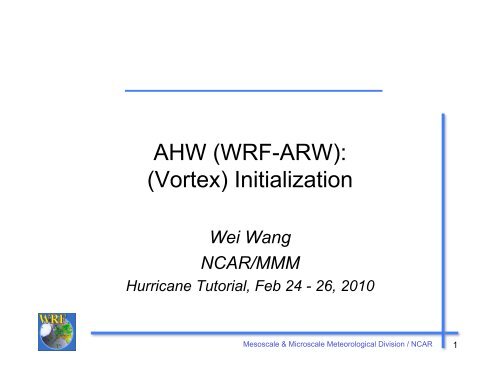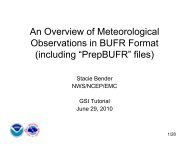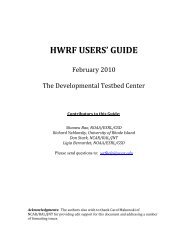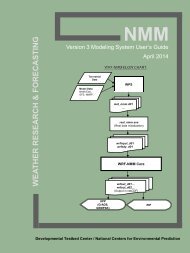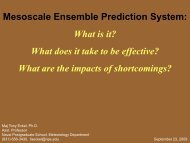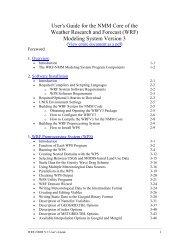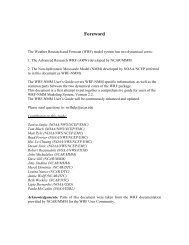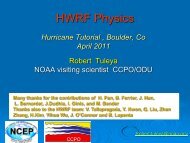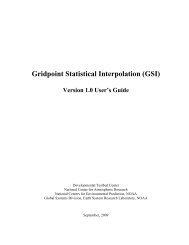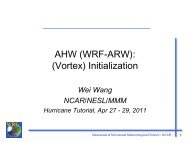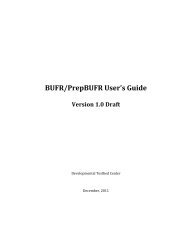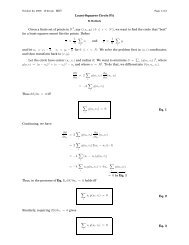AHW (WRF-ARW): (Vortex) Initialization
AHW (WRF-ARW): (Vortex) Initialization
AHW (WRF-ARW): (Vortex) Initialization
Create successful ePaper yourself
Turn your PDF publications into a flip-book with our unique Google optimized e-Paper software.
<strong>AHW</strong> (<strong>WRF</strong>-<strong>ARW</strong>):(<strong>Vortex</strong>) <strong>Initialization</strong>Wei WangNCAR/MMMHurricane Tutorial, Feb 24 - 26, 2010Mesoscale & Microscale Meteorological Division / NCAR 1
Introduction• <strong>Vortex</strong> initialization is very important tohurricane prediction• It is a challenging task, hence it is aresearch area• <strong>ARW</strong> supports a few ways to do initializationfor hurricanesooSupport researchers’ needFlexibilityMesoscale & Microscale Meteorological Division / NCAR 2
<strong>ARW</strong> (<strong>Vortex</strong>) <strong>Initialization</strong> Methods• Use data from other models directly• TC bogussing via objective analysis• TC relocation with previous forecast• TC relocation and bogussing• <strong>Initialization</strong> via obs and analysis nudging• <strong>Initialization</strong> via the use of 3DVar• <strong>Initialization</strong> via the use of 4DVar• <strong>Initialization</strong> via EnKFMesoscale & Microscale Meteorological Division / NCAR 3
Use Other Model Data DirectlyMesoscale & Microscale Meteorological Division / NCAR 4
Supported Data Sources• GFS / FNL (0.5 - 1 degree)oooOK during the early stages of stormMay be problematic when the storm becomesintenseNot for intensity• GFDL / H<strong>WRF</strong> (9 - 18 km)ooCould work for well-developed stormsImbalance during early forecast hours• ECMWF Interim Analysis (~ 80 km)oCan benefit from good environmental conditionMesoscale & Microscale Meteorological Division / NCAR 5
TC Bogussingvia Objective AnalysisMesoscale & Microscale Meteorological Division / NCAR 6
Method• Based on technique of objective analysis (e.g.Cressman)• <strong>ARW</strong> V3.1 supports such an program: obsgrid.exeoIn addition to normal synoptic observations, bogus dataeither generated from a Rankine vortex or soundingsextracted from previous model forecast• For detailed description, please see Chapter 7 ofthe User’s GuideMesoscale & Microscale Meteorological Division / NCAR 7
Pros and Cons• Advantage:oEasy to use• Disadvantage:o Relocation may be importanto Spread of data is artificialo No dynamic and thermodynamic constrainsMesoscale & Microscale Meteorological Division / NCAR 8
TC RelocationUsing Previous Model ForecastMesoscale & Microscale Meteorological Division / NCAR 9
TC Relocation• Based on the assumption that modelsimulated vortex has reasonable structure• The model vortex is lifted from a previousforecast, and moved to the current, correctlocation• Works better on pressure level data• May adjust vortex profile after relocation• Papers by Liu et al. (1997), Tenerelli et al.(2001)Mesoscale & Microscale Meteorological Division / NCAR 10
Pros and Cons• Advantage:o Easy to implement, especially with moving nest• Disadvantage:ooBlending of vortex environment may beproblematicMay have problem with storm relocating fromocean to land or vice versa• Tools available to do this:o p_interp: put model data on pressure levelsMesoscale & Microscale Meteorological Division / NCAR 11
TC Relocation and BogussingMesoscale & Microscale Meteorological Division / NCAR 12
Method• <strong>ARW</strong> V3.1 supports a simple TC bogussingscheme: tc.exe• The scheme is adapted from MM5:oooDetect and remove existing vortexBogus in a Rankine vortex based on best trackTC infoWorks on pressure level data after WPS andbefore real.exe• For details, please refer to Chapter 10 of the<strong>ARW</strong> User’s GuideMesoscale & Microscale Meteorological Division / NCAR 13
An Example for Sinlaku (2008)After <strong>Vortex</strong> RemovalAfter BogussingOriginal(From Gill and Fredrick)Mesoscale & Microscale Meteorological Division / NCAR 14
• Advantage:ooPros and ConsEasy to doProvide a placeholder for improved bogussingtechnique• Disadvantage:ooArtificial vortex dataImbalance with model solutionMesoscale & Microscale Meteorological Division / NCAR 15
<strong>Initialization</strong>via Observation and Analysis NudgingMesoscale & Microscale Meteorological Division / NCAR 16
Method• Based on observation and grid-analysisnudging technique [Stauffer and Seaman (1990,1991), Liu et al. (2008)]• Available as runtime option in <strong>ARW</strong>• Aimed at providing good analysis for thestorm environment• Can be successful when doing it continuously- hence model generated storm can berecycledMesoscale & Microscale Meteorological Division / NCAR 17
• Advantage:oooPros and ConsEasy to implementUse of modelNudging technique is being improved• Disadvantage:ooMay not work over part of the ocean whereconventional data is sparseNudging term can be arbitraryMesoscale & Microscale Meteorological Division / NCAR 18
TC Bogussing Using 3DVarMesoscale & Microscale Meteorological Division / NCAR 19
Method• Three-dimensional data assimilation (3DVar)produces an analysis by combining abackground forecast and observationsthrough an iterative minimization procedure ofa prescribed cost function• The information about background andobservation errors is used to spread data• Can assimilate many types observationsRef: Barker et al. (2004)Mesoscale & Microscale Meteorological Division / NCAR 20
Method• When 3DVar is applied to TC initialization,one can do one of two things:o Improving environmental conditions byassimilating conventional as well as remotesensed data (including radiance)o In addition, bogus data may be used. Relocationneeded• Cycling may be used to retain characteristicsof the modelMesoscale & Microscale Meteorological Division / NCAR 21
Assimilation SystemGFDLGFSGFS+AMSUAMSU+BogusMesoscale & Microscale Meteorological Division / NCAR 22(from Z.-Q. Liu)
• Advantage:ooPros and ConsGood mathematical baseComputationally efficient (relative to other moresophisticate techniques)• Disadvantage:oooBackground error covariance not changing withtime and flow regime, and can be problematic forTCSingle time-level can be limitingMay take time to learn to use the technique wellMesoscale & Microscale Meteorological Division / NCAR 23
TC <strong>Initialization</strong> Using 4DVarMesoscale & Microscale Meteorological Division / NCAR 24
Method• The difference between 3DVar and fourdimensional(4DVar) data assimilation is theuse of a numerical forecast model• The added time dimension provides flowdependentinformation• Can use observation in a time windowRef: Huang et al. (2009)Mesoscale & Microscale Meteorological Division / NCAR 25
An Example:<strong>WRF</strong> 3D/4D-Var for Katrina 2005• <strong>WRF</strong> Domains : D1-D3 with 40.5km, 13.5km, 4.5 kmgrids and 35 vertical levels; Data assimilations onlyapplied on D1• Forecasts: 96-h deterministic run with D1, D2, D3(two-way nested and D3 movable) initialized from00Z August 26 2005 with various Ics• Data assimilated: Doppler radial velocity (err=3m/s)from KMAX and KBYX during 00~03Z August 262005Mesoscale & Microscale Meteorological Division / NCAR 26
Track and Intensity Forecast on Aug 26, 2005(from M. Zhang)Mesoscale & Microscale Meteorological Division / NCAR 28
• Advantage:oooPros and ConsGood mathematical baseUse of model for dynamic and thermodynamicconstrainFlow dependent• Disadvantage:ooExpensive techniqueProbably long learning curveMesoscale & Microscale Meteorological Division / NCAR 29
TC <strong>Initialization</strong> Using EnKFMesoscale & Microscale Meteorological Division / NCAR 30
Methodanalysis ensembleforecast ensemblenew analysis ensemblex = x + K( y−Hx)a b bb T b T −1K = P H ( HP H + R)(from R. Torn)Mesoscale & Microscale Meteorological Division / NCAR 31
Assimilation System• <strong>WRF</strong> <strong>ARW</strong> (v3.1), 36 km horizontal resolution, 96ensemble members, DART assimilation system(http://www.image.ucar.edu/DAReS/DART/index.php)• Observations assimilated each six hours fromsurface and marine stations (Psfc), rawinsondes,synoptic dropsondes, ACARS, sat. winds, TCposition and minimum SLP• Initialized system a couple of days before anydeveloping storm. System cycled continuouslybeyond that pointMesoscale & Microscale Meteorological Division / NCAR 32
Assimilation SystemMesoscale & Microscale Meteorological Division / NCAR 33
Cycling Error for Position and Intensity (2009)RMSBIASMesoscale & Microscale Meteorological Division / NCAR 34
Cycling Error for Wind Radii (2009)RMSBIASMesoscale & Microscale Meteorological Division / NCAR 35
Intensity Forecast for ErikaMesoscale & Microscale Meteorological Division / NCAR 36
Intensity Forecast for Rita (2005)Mesoscale & Microscale Meteorological Division / NCAR 37
Pros and Cons• Advantage:o No boguso Aimed at improving storm environment• Weakness:o Intensity low bias due to low resolutiono Can be computationally demandingMesoscale & Microscale Meteorological Division / NCAR 38
In Summary…• TC initialization still a challenge• Experimentation is needed for large sample ofcases: a technique working for one case may notwork for another• The need in research and operation may bedifferent• The results of using various methods seem tosuggest that some kind of cycling method tends toperform betterMesoscale & Microscale Meteorological Division / NCAR 39


